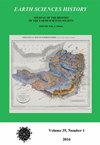戈登-莱尔-帕弗(1913-1988 年)和南非工兵团第 42 地质分队:二战中支持英军作战的军事地质学和地球物理学:第一部分,1940-1941 年东非战役
IF 0.6
4区 哲学
Q4 GEOSCIENCES, MULTIDISCIPLINARY
引用次数: 0
摘要
南非工兵部队第 42 地质分队是一支独特的部队,在第二次世界大战期间为英国武装部队提供支持。戈登-莱尔-帕弗(Gordon Lyall Paver,1913-1988 年)是这支部队的创始人之一,并在战争的大部分时间里领导着这支部队。帕弗出生于南非约翰内斯堡,早年就读于圣约翰学院,1926 年起在英国切特豪斯学校接受教育,1931 年进入剑桥大学彭布罗克学院学习化学、地质学和矿物学。1934 年毕业后,他回到南非,被南非地质调查局任命为首批地球物理学家之一,并参与了德兰士瓦地区的磁力测量和重力测量工作,1938 年至 1940 年,他利用这些专业知识起草了博士学位论文(1942 年获得)。虽然帕弗于 1939 年结婚,并曾短暂受聘为地球物理学家顾问,但 1940 年 8 月,帕弗作为首批三名地球科学家之一,作为军官被动员到南非比勒陀利亚附近的宗德沃特(Zonderwater),创建第 42 地质分部。经过短短一个月的军事训练,9 月底,地质分队及其车辆通过铁路和海路部署到肯尼亚内罗毕附近的基地,前往东非执行任务,"代理队长 "帕弗担任分队副队长。该科的分遣队被广泛部署在肯尼亚,后来又部署在意大利和英国的索马里兰(今索马里),以及阿比西尼亚(今埃塞俄比亚),主要利用地球电阻率进行勘测,也利用垂直力磁强计进行勘测。在 "英军 "东非战役期间,这些勘测为南非工兵团的另一支部队钻井提供了指导,以抽取可饮用的地下水,从而促进了部队在干旱或半干旱地区的集结和前进。该科成员还编制了比例尺为 1:1,000,000 和 1:2,000,000 的肯尼亚地质图,并率先在东非工兵内部成立了一个军事地质单位,从 1941 年到 1945 年为该地区的英军提供支持。1941 年,战役胜利结束,从 8 月底开始,地质分队向北重新部署到埃及开罗附近的一个基地。从 8 月 31 日起,帕弗被晋升为 "代理少校",12 月,他因早先在东非的出色表现而被 "上报"。本文章由计算机程序翻译,如有差异,请以英文原文为准。
GORDON LYALL PAVER (1913–1988) AND 42ND GEOLOGICAL SECTION, SOUTH AFRICAN ENGINEER CORPS: MILITARY GEOLOGY AND GEOPHYSICS IN WORLD WAR II SUPPORTING BRITISH ARMY OPERATIONS: PART 1, THE EAST AFRICAN CAMPAIGN 1940–1941
42nd Geological Section of the South African Engineer Corps was a unique unit that supported British armed forces during World War II. It was co-founded and led for most of the war by Gordon Lyall Paver (1913–1988), one of the few ‘British’ officers serving specifically as geologists during the war to achieve the rank of major. Born in South Africa at Johannesburg and in his early years educated there at St. John's College, from 1926 Paver was educated in England, at Charterhouse School until admitted in 1931 to Pembroke College in the University of Cambridge, where he studied chemistry, geology and mineralogy. He graduated in 1934 and returned to South Africa, being appointed to the Geological Survey of South Africa as one of its first geophysicists and contributing to magnetometric and gravimetric surveys in the Transvaal region, expertise used in 1938 to 1940 to draft his thesis for a PhD degree (awarded in 1942). Although married in 1939 and briefly employed as a consultant geophysicist, in August 1940 Paver was one of the first three geoscientists to be mobilized as officers to found 42nd Geological Section, at Zonderwater near Pretoria in South Africa. After only a month's military training, at the end of September the Section and its vehicles deployed by rail and sea to a base near Nairobi in Kenya for operational service in East Africa, with ‘Acting Captain’ Paver as its Second-in-Command. Detachments from the Section were widely deployed in Kenya and later in Italian and British Somaliland (present-day Somalia) and also in Abyssinia (present-day Ethiopia) for surveys by means primarily of electrical earth resistivity but also vertical force magnetometer. These guided drilling of wells by another unit of the South African Engineer Corps to abstract potable groundwater— thereby facilitating troop concentrations and forward movements in arid or semi-arid regions during the ‘British’ Army's East African Campaign. Members of the Section also compiled geological maps of Kenya at scales of 1:1,000,000 and 1:2,000,000 and pioneered a military geological unit created within the East African Engineers that supported British forces in the region from 1941 to 1945. The Campaign drew to a victorious close during 1941 and, from the end of August, the Section was re-deployed northwards to a base near Cairo in Egypt. It continued to serve within the British Army's Middle East Command but with leadership now by Paver, promoted ‘Acting Major’ from 31 August and in December ‘mentioned in despatches’ for his earlier distinguished service in East Africa.
求助全文
通过发布文献求助,成功后即可免费获取论文全文。
去求助
来源期刊

Earth Sciences History
GEOSCIENCES, MULTIDISCIPLINARY-HISTORY & PHILOSOPHY OF SCIENCE
CiteScore
1.00
自引率
0.00%
发文量
1
审稿时长
>12 weeks
期刊介绍:
Earth Sciences History promotes and publishes historical work on all areas of the earth sciences – including geology, geography, geophysics, oceanography, paleontology, meteorology, and climatology.
The journal honors and encourages a variety of approaches to historical study: biography, history of ideas, social history, and histories of institutions, organizations, and techniques.
Articles are peer reviewed.
 求助内容:
求助内容: 应助结果提醒方式:
应助结果提醒方式:


